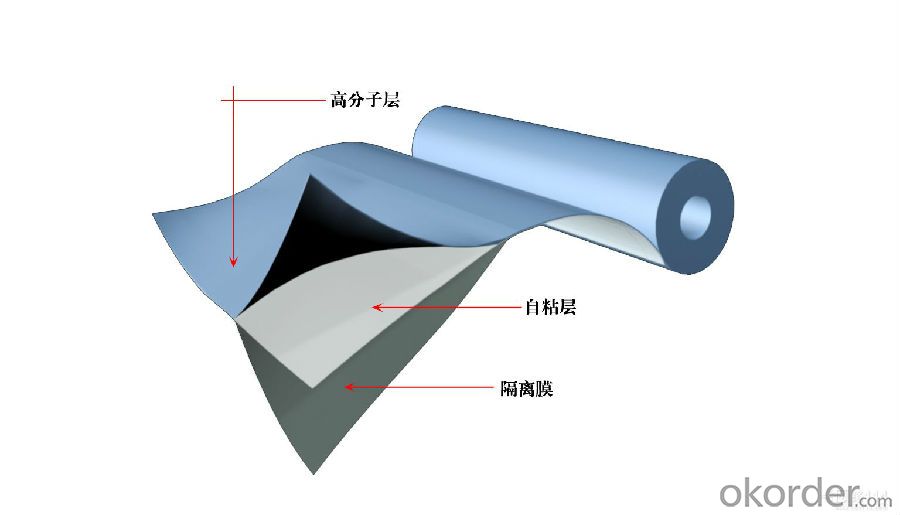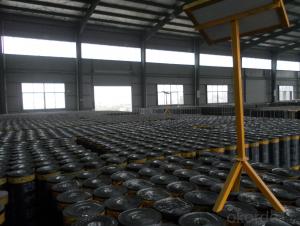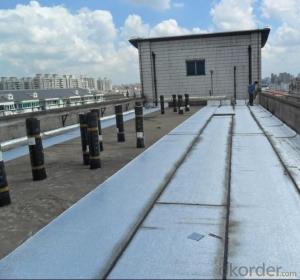Self Adhesive Bitumen Waterproof Membrane for Roofing
- Loading Port:
- China main port
- Payment Terms:
- TT OR LC
- Min Order Qty:
- 5000 m²
- Supply Capability:
- 100000 m²/month
OKorder Service Pledge
OKorder Financial Service
You Might Also Like
Introduction
Self adhesive waterproofing material ismade by saturating the base in bitumen, or thermoplastic elastomer (such as styrene butadiene), reinforced with polyester or fiberglass, finishing the upward face with fine sands, mineral slates (or grains) or polythene membrane etc. It has the outstanding performance such as: convenient to apply, no environmental pollution etc. This product is consisting of two kinds: without reinforcement and polyester reinforcement.
Specification
Thickness | 3mm, 4mm, 5mm |
Width | 1m |
length | 7.5m, 10m, 15m, or on demand |
Base | Polyester or Fiberglass felt |
Surface | PE film, Aluminum foil, Yellow sand, Shale gravel(Schist), colored sand |
Type | could self-adhesive |
Notice | SBS modified bitumen membrane is specially applied in the cold district, APP modified bitumen membrane is more suitable for hot district with high temperature. could be self-adhesive modified bitumen membrane |
Advantages
1) Cold-applied construction with no open flame and self-adhesion without bonding agent make it safe, low- carbon, environmental, and economical.
2) Excellent adhesive performance guarantees the integrity of waterproof layer.
3) Good rubber elasticity, elongation and shear stress.
4) Good low-temperature property.
FAQ
1. Is sample available before place orders?
A: Yes, sample is ok.
2. How long is the dispatch period?
A: It will be around 20-30 days.

- Q:Can a waterproofing membrane be used in chemical or hazardous environments?
- Yes, a waterproofing membrane can be used in chemical or hazardous environments. Waterproofing membranes are designed to provide a barrier against water, moisture, and other liquids, which can also include chemicals and hazardous substances. These membranes are typically made of materials that are resistant to chemicals, such as polyurethane, PVC, or modified bitumen, to ensure they can withstand exposure to various chemicals without being damaged or compromised. However, it is important to select a waterproofing membrane specifically designed for chemical or hazardous environments to ensure it meets the necessary requirements and standards for such applications. Additionally, proper installation and maintenance are crucial to ensure the effectiveness and longevity of the waterproofing membrane in these environments.
- Q:Can a waterproofing membrane be used for a tunnel?
- Yes, a waterproofing membrane can be used for a tunnel. Waterproofing membranes are commonly used in tunnel construction to prevent water infiltration and protect the tunnel structure from potential damage caused by water. These membranes act as a barrier, preventing the passage of water and ensuring the tunnel remains dry and structurally sound.
- Q:What are the common mistakes to avoid when installing a waterproofing membrane?
- Some common mistakes to avoid when installing a waterproofing membrane include inadequate surface preparation, improper selection of the membrane material, improper seam sealing, insufficient coverage or overlap of the membrane, and failure to test for leaks before covering the membrane.
- Q:Can a waterproofing membrane be used on below-grade walls?
- Indeed, a waterproofing membrane is capable of being employed on walls located below ground level. In fact, it is highly advisable to utilize a waterproofing membrane on such walls so as to shield them against infiltration of water and potential harm caused by moisture. Walls situated below ground level are especially susceptible to water penetration due to their proximity to the ground and the possibility of hydrostatic pressure. A waterproofing membrane serves as a protective barrier, effectively preventing water from seeping into the walls and leading to issues such as mold, mildew, decay, and structural impairment. Moreover, it aids in maintaining the interior of the edifice in a dry condition, thereby averting potential problems related to moisture.
- Q:Does a waterproofing membrane prevent water damage to building materials?
- Yes, a waterproofing membrane is designed to prevent water damage to building materials. It acts as a barrier that prevents water from penetrating into the structure and causing damage. The membrane is typically applied to areas that are susceptible to water intrusion, such as roofs, basements, and foundations. By creating a waterproof seal, it effectively prevents water from seeping through and damaging the building materials. This helps to protect the integrity of the structure and can prevent issues such as mold growth, rotting, and deterioration of materials. However, it is important to note that the effectiveness of a waterproofing membrane can vary depending on the quality of the product and the proper installation. Regular maintenance and inspections are also necessary to ensure that the membrane remains intact and continues to provide protection against water damage.
- Q:Can a waterproofing membrane be installed by a homeowner, or is professional installation necessary?
- While it is technically possible for a homeowner to install a waterproofing membrane, professional installation is highly recommended. Waterproofing membranes require specialized knowledge and expertise to ensure proper installation and effectiveness. Professionals have the necessary skills, tools, and experience to address potential challenges and ensure a long-lasting and reliable waterproofing solution. Additionally, professional installation often comes with warranties and guarantees, providing homeowners with added peace of mind.
- Q:Does a waterproofing membrane prevent water infiltration through concrete or other building materials?
- Yes, a waterproofing membrane is designed to prevent water infiltration through concrete or other building materials. It acts as a protective barrier that is applied to the surface of the material, forming a water-resistant layer. This membrane can be made from various materials such as bitumen, rubberized asphalt, or liquid polymers. When properly installed, it can effectively prevent water from seeping through the concrete or other building materials, thus protecting the structure from potential water damage or moisture-related issues.
- Q:Does a waterproofing membrane affect the structural integrity of a building?
- Typically, the structural integrity of a building is not affected by a waterproofing membrane. Instead, the membrane is specifically designed to safeguard the structural components of the building by preventing water infiltration and subsequent harm. Acting as a barrier against water penetration, the waterproofing membrane ensures that the building remains dry and free from moisture-related issues such as mold, rot, or deterioration. By preserving the building envelope, the membrane aids in maintaining the structural integrity of the building and prolonging its lifespan. It is crucial to note that the installation of a waterproofing membrane must be executed correctly and in accordance with industry standards to guarantee its effectiveness and prevent any potential negative impact on the structure.
- Q:Can waterproofing membranes be used on loading docks?
- Indeed, loading docks can make use of waterproofing membranes. These membranes have been specifically crafted to create a shield against water infiltration, rendering them appropriate for a range of uses, including loading docks. The installation of waterproofing membranes on loading docks serves to thwart water damage and leakage into the underlying framework, thus safeguarding the dock's integrity and durability. Moreover, the utilization of waterproofing membranes can contribute to increased safety by minimizing the potential for accidents resulting from slippery surfaces on loading docks.
- Q:Can a waterproofing membrane be used on roofs with skylights?
- Certainly, roofs with skylights can benefit from the use of a waterproofing membrane. It is strongly advised to employ a waterproofing membrane around skylights in order to prevent water infiltration or leakage. Skylights have the potential to become weak points in a roof system, as they form openings that can let water seep through if not adequately sealed. The application of a waterproofing membrane around the skylights serves to establish a watertight barrier that safeguards the roof from any potential leaks. Furthermore, a waterproofing membrane also offers added protection against external factors such as UV rays and changes in temperature, thereby extending the lifespan of both the skylights and the roof itself.
1. Manufacturer Overview |
|
|---|---|
| Location | |
| Year Established | |
| Annual Output Value | |
| Main Markets | |
| Company Certifications | |
2. Manufacturer Certificates |
|
|---|---|
| a) Certification Name | |
| Range | |
| Reference | |
| Validity Period | |
3. Manufacturer Capability |
|
|---|---|
| a)Trade Capacity | |
| Nearest Port | |
| Export Percentage | |
| No.of Employees in Trade Department | |
| Language Spoken: | |
| b)Factory Information | |
| Factory Size: | |
| No. of Production Lines | |
| Contract Manufacturing | |
| Product Price Range | |
Send your message to us
Self Adhesive Bitumen Waterproof Membrane for Roofing
- Loading Port:
- China main port
- Payment Terms:
- TT OR LC
- Min Order Qty:
- 5000 m²
- Supply Capability:
- 100000 m²/month
OKorder Service Pledge
OKorder Financial Service
Similar products
New products
Hot products
Hot Searches
Related keywords



























